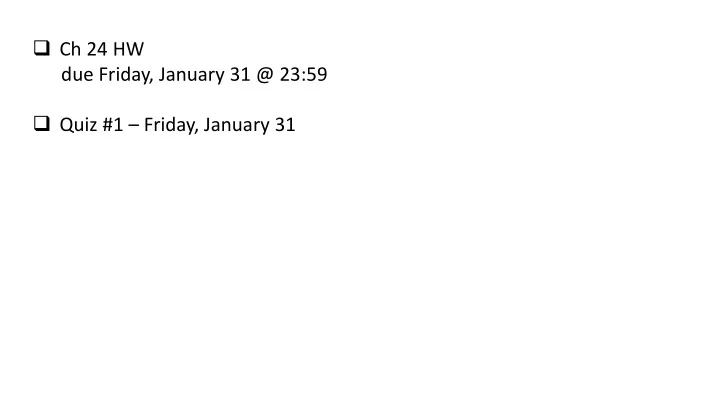

❑ Ch 24 HW due Friday, January 31 @ 23:59 ❑ Quiz #1 – Friday, January 31
QuickCheck 24.8 Which spherical Gaussian surface has the larger electric flux? A. Surface A B. Surface B C. They have the same flux. D. Not enough information to tell.
QuickCheck 24.8 Which spherical Gaussian surface has the larger electric flux? A. Surface A B. Surface B C. They have the same flux. D. Not enough information to tell. Flux depends only on the enclosed charge, not the radius.
QuickCheck 24.10 A spherical Gaussian surface surrounds an electric dipole. The net enclosed charge is zero. Which is true? A. The electric field is zero everywhere on the Gaussian surface. B. The electric field is not zero everywhere on the Gaussian surface. C. Whether or not the field is zero on the surface depends on where the dipole is inside the sphere.
QuickCheck 24.10 A spherical Gaussian surface surrounds an electric dipole. The net enclosed charge is zero. Which is true? A. The electric field is zero everywhere on the Gaussian surface. B. The electric field is not zero everywhere on the Gaussian surface. C. Whether or not the field is zero on the surface depends on where the dipole is inside the sphere. The flux is zero, but that doesn’t require the field to be zero.
QuickCheck 24.11 The electric flux is shown through two Gaussian surfaces. In terms of q , what are charges q 1 and q 2 ? A. q 1 = 2 q ; q 2 = q q 2 B. q 1 = q ; q 2 = 2 q q 1 = 2 q ; q 2 = – q C. q 1 = 2 q ; q 2 = – 2 q D. E. q 1 = q/2 ; q 2 = q/2
QuickCheck 24.11 The electric flux is shown through two Gaussian surfaces. In terms of q , what are charges q 1 and q 2 ? A. q 1 = 2 q ; q 2 = q q 2 B. q 1 = q ; q 2 = 2 q q 1 = 2 q ; q 2 = – q C. q 1 = 2 q ; q 2 = – 2 q D. E. q 1 = q/2 ; q 2 = q/2
Recommend
More recommend